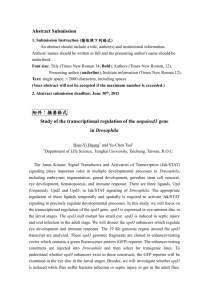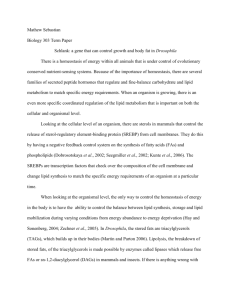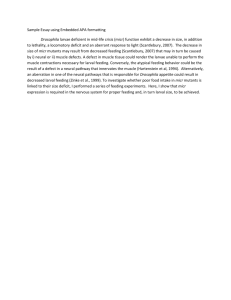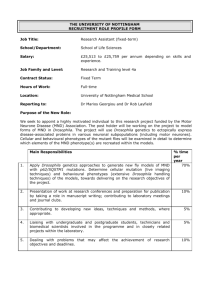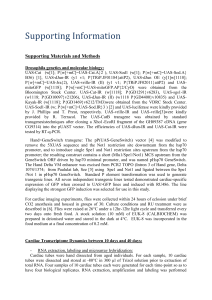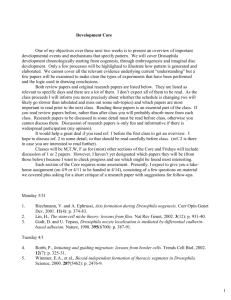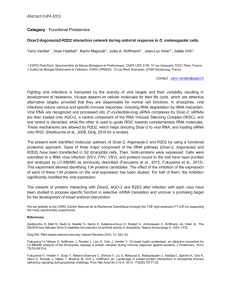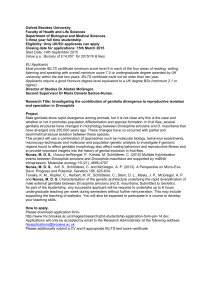S1 Text: Supplemental text with methods and references
advertisement
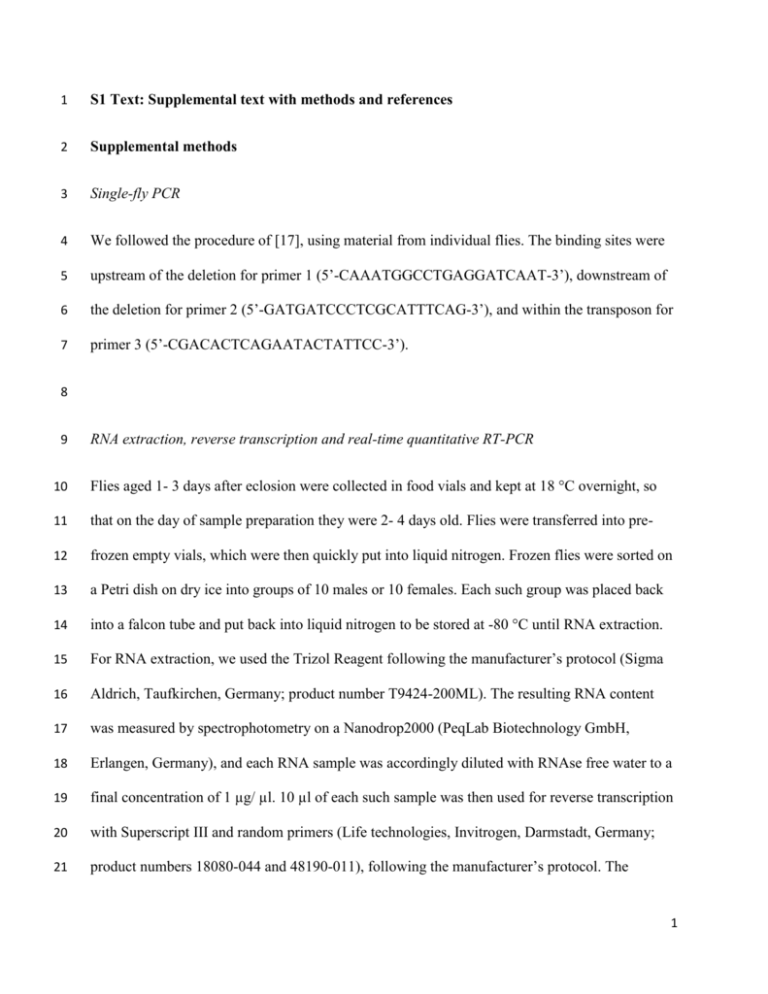
1 S1 Text: Supplemental text with methods and references 2 Supplemental methods 3 Single-fly PCR 4 We followed the procedure of [17], using material from individual flies. The binding sites were 5 upstream of the deletion for primer 1 (5’-CAAATGGCCTGAGGATCAAT-3’), downstream of 6 the deletion for primer 2 (5’-GATGATCCCTCGCATTTCAG-3’), and within the transposon for 7 primer 3 (5’-CGACACTCAGAATACTATTCC-3’). 8 9 RNA extraction, reverse transcription and real-time quantitative RT-PCR 10 Flies aged 1- 3 days after eclosion were collected in food vials and kept at 18 °C overnight, so 11 that on the day of sample preparation they were 2- 4 days old. Flies were transferred into pre- 12 frozen empty vials, which were then quickly put into liquid nitrogen. Frozen flies were sorted on 13 a Petri dish on dry ice into groups of 10 males or 10 females. Each such group was placed back 14 into a falcon tube and put back into liquid nitrogen to be stored at -80 °C until RNA extraction. 15 For RNA extraction, we used the Trizol Reagent following the manufacturer’s protocol (Sigma 16 Aldrich, Taufkirchen, Germany; product number T9424-200ML). The resulting RNA content 17 was measured by spectrophotometry on a Nanodrop2000 (PeqLab Biotechnology GmbH, 18 Erlangen, Germany), and each RNA sample was accordingly diluted with RNAse free water to a 19 final concentration of 1 µg/ µl. 10 µl of each such sample was then used for reverse transcription 20 with Superscript III and random primers (Life technologies, Invitrogen, Darmstadt, Germany; 21 product numbers 18080-044 and 48190-011), following the manufacturer’s protocol. The 1 22 resulting cDNA samples were stored at -20 °C until real-time quantitative PCR, which was 23 performed on a 7500 Fast Real-Time PCR System (Applied Biosystems, Darmstadt, Germany) 24 following the manufacturer’s protocol, thus using 8µl of cDNA sample, 2µl of a primer-mix (5 25 pmol/ µl per primer) and 10µl FastSybrGreen Master Mix (Applied Biosystems, Darmstadt, 26 Germany; product number 4385614) to reach a total of 20 µl reaction volume. For each gene of 27 interest and the housekeeping gene rp49, we designed 20 b forward and reverse oligonucleotide 28 primers, such that the amplified product size ranged 70- 150 bp (see the table below for primer 29 sequences). For primer-design, the software Primer3 version 4.0 ( http://frodo.wi.mit.edu/, [18]) 30 together with the Drosophila mis-priming library was used. The oligonucleotides were 31 synthesized by Metabion (Martinsried, Germany). 32 We analyzed with real-time quantitative PCR 2-12 independent cDNA samples for each 33 genotype and sex (S7 Table). Each sample that was included in a given run was loaded twice, 34 once to amplify a fragment of the cDNA of interest and once to amplify a fragment of rp49 35 cDNA (http://www.roche-applied-science.com/sis/rtpcr/upl/index). For each case, a CT value 36 was calculated as the number of cycles to reach a particular amount of amplified product, 37 characterized by a fluorescence intensity threshold of ~ 0.05, which was in the linear phase of the 38 cycle number – fluorescence intensity curves. Then, for each sample, a Delta CT was calculated 39 by subtracting the CT value of the rp49-amplification from the CT value of the gene of interest- 40 amplification. These Delta CT values were then plotted comparatively between mutants and 41 controls for each sex (S2A Fig.). To assess the fold changes in S7 Table, we calculated for each 42 genotype and sex the Median Delta CT values. If, e.g, the Median Delta CT of a mutant was 4 43 units larger than that of the control, this implied a 24 = 16- fold decrease in the level of the 44 respective mRNA in the mutant (S2B Fig., S7 Table). 2 Targeted gene Forward primer 5’3’ Reverse primer 5’3’ CG3711 GTTCCCACACTCACCTTCGT TGCAGTCAGGGAGGTACACA Rca1 TGGACGTACAACCAGCACAT TCCTGACCTCGTCAAGATCC rad50 AATTGAATCGCTGTCCATCC ACCGGCGAGGAAAACTTTAT CG15107 CTGGAACCATCGAGCCTTAG GAGTTGGTGGATGAGGAGGA CG13397 TCCAAAAGGGATTCTTCACG GATCCCTTCAACGAACTGGA wat CTTTGGCCAGCTTGATGATT CATGGAGAACGTCAACATCG Tsp42Ei GCCGCTGTATCCGAAAGATA GCGCAGTAGAGTGCATCAGA CG16865 AGCCCACAACTGGGACATAG TAAGTGCCGTCCACTCACTG CG3290 TTTCCACTACCAACGCATGA ACCTTTTCACCGGAGTGATG CG13793 GAGAACGGAAGGGACATGAA TGCGACAATAGCTGAGGAAGT Cyp4d21 GTGGACTTCTCGCAGAAAGG GAATAGGTCCACGCACGTTT CG15170 CCAAACTCCGTAACCTGCAT TGTCGCACTTGTCACAGTCA rp49 CGGATCGATATGCTAAGCTGT GCGCTTGTTCGATCCGTA 45 46 Supplemental references 47 1. Marygold SJ, Leyland PC, Seal RL, Goodman JL, Thurmond J, Strelets VB, et al. (2013) 48 FlyBase: improvements to the bibliography. Nucleic Acids Res 41: D751-757. 3 49 50 2. Neely GG1, Hess A, Costigan M, Keene AC, Goulas S, Langeslag M, et al. (2010) A genome- 51 wide Drosophila screen for heat nociception identifies α2δ3 as an evolutionarily 52 conserved pain 53 gene. Cell 143: 628-638. 54 55 3. Hong S-T, Bang S, Hyun S, Kang J, Jeong K, Paik D, et al. (2008) cAMP signalling in 56 mushroom bodies modulates temperature preference behaviour in Drosophila. Nature 57 454: 771-775. 58 59 4. Tan Y, Yu D, Pletting J, Davis RL (2010) Gilgamesh is required for rutabaga-independent 60 olfactory learning in Drosophila. Neuron 67: 810-820. 61 62 5. Quinn WG, Sziber PP, Booker R (1979) The Drosophila memory mutant amnesiac. Nature 63 277: 212-214. 64 65 6. Qiu Y, Davis RL (1993) Genetic dissection of the learning/memory gene dunce of 66 Drosophila melanogaster. Genes Dev 7: 1447-1458. 67 68 7. Gouzi JY, Moressis A, Walker JA, Apostolopoulou AA, Palmer RH, Bernards A, et. al. (2011) 69 The receptor tyrosine kinase Alk controls neurofibromin functions in Drosophila growth 70 and 71 learning. PLoS Genet 7: e1002281. 4 72 73 8. Bolduc FV, Bell K, Cox H, Broadie KS, Tully T (2008) Excess protein synthesis in 74 Drosophila fragile X mutants impairs long-term memory. Nat Neurosci 11: 1143-1145. 75 76 9. Akalal DB, Yu D, Davis RL. (2011) The long-term memory trace formed in the 77 Drosophila α/β mushroom body neurons is abolished in long-term memory mutants. J Neurosci 78 31: 5643-5647. 79 80 10. Norga KK, Gurganus MC, Dilda CL, Yamamoto A, Lyman RF, Patel PH, et al. (2003) 81 Quantitative analysis of bristle number in Drosophila mutants identifies genes involved in 82 neural 83 development. Curr Biol 13: 1388-1396. 84 85 11. Mummery-Widmer JL, Yamazaki M, Stoeger T, Novatchkova M, Bhalerao S, Chen D, et al. 86 (2009) Genome-wide analysis of Notch signalling in Drosophila by transgenic RNAi. Nature 87 458: 987-992. 88 89 12. Leviten MW, Posakony JW. (1996) Gain-of-function alleles of Bearded interfere with 90 alternative cell fate decisions in Drosophila adult sensory organ development. Dev Biol. 176: 91 264-283. 92 5 93 13. Ciapponi L, Cenci G, Ducau J, Flores C, Johnson-Schlitz D, Gorski MM, et al. (2004) The 94 Drosophila Mre11/Rad50 complex is required to prevent both telomeric fusion and 95 chromosome 96 breakage. Curr Biol 14: 1360-1366. 97 98 14. Huang DW, Sherman BT, Lempicki RA. (2009) Systematic and integrative analysis of large 99 gene lists using DAVID Bioinformatics Resources. Nature Protoc 4:44-57. 100 101 15. Huang DW, Sherman BT, Lempicki RA. (2009) Bioinformatics enrichment tools: paths 102 toward the comprehensive functional analysis of large gene lists. Nucleic Acids Res 37: 1-13. 103 104 16. Török I, Herrmann-Horle D, Kiss I, Tick G, Speer G, Schmitt R et al. (1999) Down- 105 regulation of RpS21, a putative translation initiation factor interacting with P40, produces 106 viable minute 107 imagos and larval lethality with overgrown hematopoietic organs and imaginal discs. Mol 108 Cell Biol 19: 2308-2321. 109 110 17. Gloor GB, Preston CR, Johnson-Schlitz DM, Nassif NA, Phillis RW, Benz WK, et al. 111 (1993). Type I repressors of P element mobility. Genetics 135: 81–95. 112 113 18. Rozen S, Skaletsky H (2000) Primer3 on the WWW for general users and for biologist 114 programmers. Methods Mol Biol 132: 365-386. 6


